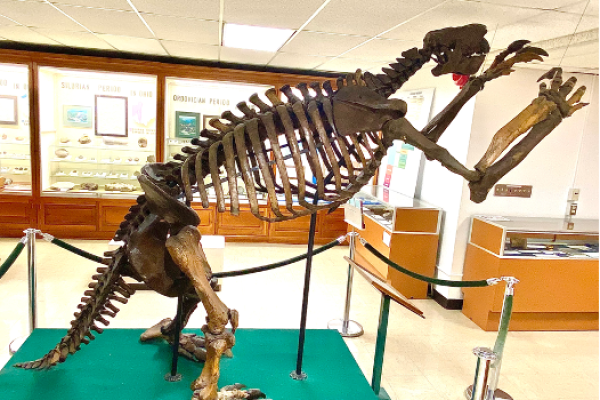In paleontology, correct names are keys to accurate study: Researcher resolves historical inconsistencies in name of popular fossil

Originally posted by Ohio State News. Author: Tatyana Woodall.
When the skeletal remains of a giant ground sloth were first unearthed in 1796, the discovery marked one of the earliest paleontological finds in American history.
The animal, named Megalonyx by Thomas Jefferson in 1799, was the first genus of fossil named from the United States. Thought to have roamed North America during one of the last ice ages, the extinct giant ground sloth was an herbivorous mammal resembling a large bear — at full size, it likely reached nearly 10 feet tall (3 meters) and weighed about as much as a small elephant.
The report made by Jefferson, an avid fossil collector who was known to keep bones at the White House, was among the earliest papers in the scientific field that would eventually become paleontology, and may have played a role in the development of certain zoological naming conventions.
Though Jefferson named only the genus Megalonyx, public misinterpretation of the spelling of the scientific name began with the second published paper on this giant ground sloth. Later on, confusion about the true author and timing of the report caused paleontologists to debate over the specimen’s true name.
In an effort to settle the dispute, Loren Babcock, a professor of earth sciences at Ohio State University, reviewed the animal's nomenclatural history and argued that misinterpretation or spelling errors in the original harm the scientific process and disregard the importance of early paleontological work.
In an article published recently in the journal ZooKeys, Babcock asserts that since Jefferson fulfilled all the necessary requirements for establishing the formal zoological name of the giant ground sloth, he should be recognized as the true author of the genus. And because Jefferson’s original moniker was spelled as Megalonyx, any other subsequent spellings of the name, like some that utilize the -onix suffix, are incorrect. Additionally, the report notes that the original spelling of the animal’s species-group name, Megalonyx jeffersonii, is only correct when written with an –ii ending.
“At the time, there were no standards for publishing new names in zoology,” said Babcock. There was a binomial system of nomenclature, a genus and species name that would be attached to things, but there were no rules other than that.”
Today, when a new species is discovered, scientists give it a name with two parts: The first name describes the animal’s genus, or group, and the second is its species name. Until the mid-1800s, labeling animals with only a genus name was common, which is how Jefferson’s original paper described Megalonyx. Although his observations were published more than a quarter century before paleontology was considered a formal science, it does meet modern naming requirements – meaning his authorship is valid, said Babcock.
“We have rules in science, just like we do in other aspects of our culture,” said Babcock. They ensure that the correct procedures are followed and that we can give credit where credit is due.”
Babcock said it's important to resolve some of these long-standing issues and set the record straight. “I want to set the original usage in stone because Jefferson had done it correctly from the start,” said Babcock. It’s pretty black and white. There’s little room for ambiguity when you return and read the original manuscripts.”
In the long run, strict naming conventions also help scientists accurately document the history of life on Earth because what paleontologists choose to call a specimen can have profound implications for how it’s studied and how those findings are communicated.
Megalonyx jeffersonii, for instance, was initially mistaken as a carnivore when its “giant claw” was compared to that of a large African lion. Jefferson soon corrected this, but his initial observations of the giant ground sloth’s remains contributed to how Megalonyx would later be reconstructed, influenced some of the earliest developments of the discipline, and earned him the title of father of American paleontology, said Babcock.
Decades later, the first relatively complete skeleton of Megalonyx jeffersonii was found in 1890 in Holmes County, Ohio. “This skeleton has had a major impact on the history of science,” Babcock said. “It’s really influenced so much of the perception of paleontology and paleontological art over time.”
As one of the earliest free-standing prehistoric specimens to be mounted and displayed in an American museum, it’s been a unique learning tool for past and future paleontologists. Babcock said it was also a model that was later applied for dinosaur skeleton reconstructions. This popularity has led many other versions of Megalonyx jeffersonii to appear across digital media and pop culture throughout the past century, most notably in the “Ice Age” films as Sid the ground sloth.
Today, the reconstructed skeleton of Megalonyx jeffersonii resides in Ohio State’s Orton Geological Museum, where it has been on display since April 13, 1896. And for decades, many have known it as simply “Jeff” for short.
Although few truly know all the details of its backstory, Babcock, the current director of the Orton Museum, remains confident that the legacy of Thomas Jefferson’s Megalonyx jeffersonii will stand tall for centuries.
“Understanding the history of paleontology casts light not just on the evolution of organisms but also on the evolution of science and how we interpret that evolutionary history,” he said. So names are something that I think historians will always pay attention to.”
